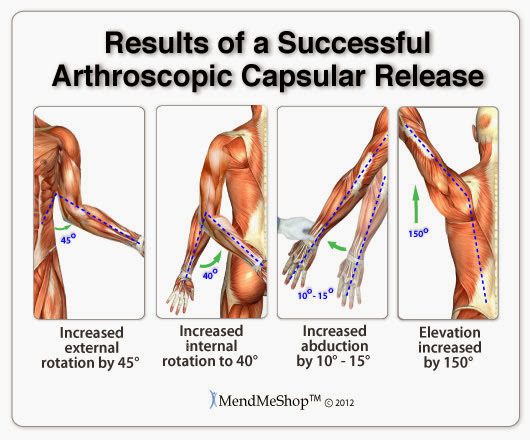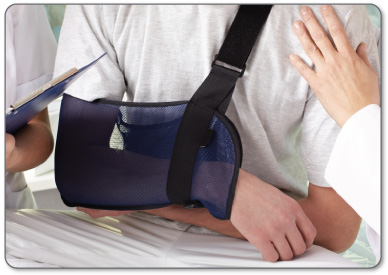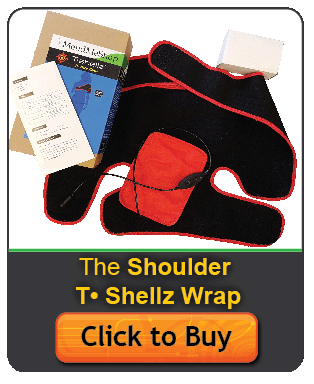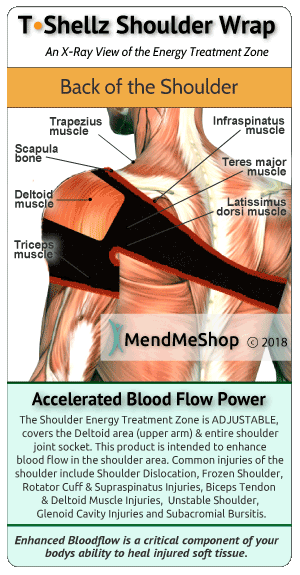It is generally agreed upon by doctors and surgeons that surgery will introduce more scar tissue into the shoulder joint capsule. This added scar tissue will be problematic, requiring intensive PT and conservative treatment options post-surgery. If not dealt with properly, your frozen shoulder injury could end up in worse condition than before the surgery! This is why surgery is only performed as a last resort.
Most doctors, physicians and orthopedic specialists will recommend conservative treatments for early cases of frozen shoulder injuries (in the freezing stage) before considering surgery. These conservative treatments are outlined near the top of the page here.
If you are unsure about whether you need shoulder surgery, consider reading through our "Do I Need Shoulder Surgery" page.
If you are unsure about whether you need shoulder manipulation, consider reading through our "Do I Need Shoulder Manipulation" page.
If you are not at the surgery stage and your physician has opted to treat your injury with conservative treatment options, then you will find that many of our frozen shoulder customers have had great success treating themselves with the powerful conservative treatment products we offer through AidMyFrozenShoulder - the TShellz Wraps. When used as directed, it is our opinion that adding the TShellz Wrap to your conservative treatments will give you the best chance of healing your frozen shoulder without the need for surgery.
The TShellz Wrap® will not only enhance blood flow in the treatment area, it will also help prevent soft tissue atrophy by increasing elasticity of the affected soft tissue. This increased elasticity will reduce your risk of re-injury or worsening the injury.
If surgical intervention is required, talk with your doctor about using these same products for post-surgery recovery as you will find them to be highly effective for reducing post-surgery inflammation, enhancing range of motion and minimizing scar tissue growth (which is a substantial problem in nearly any case of shoulder surgery).
Manipulation is an aggressive approach that involves stretching the shoulder while you're under general anaesthetia. You get put to sleep during this procedure as the process of forcing your shoulder through the full range of motion (past your point of comfort) can be quite painful. This procedure is basically meant to tear and rip up the scar tissue in your joint to force a new healing cycle for new swelling, inflammation and tissue repair. The hope is that this procedure will get the range of motion back in your shoulder.

In order to make sure your frozen shoulder injury doesn't come back, you'll have to go to PT afterwards to maintain shoulder mobility. You probably won't notice an immediate difference or change in your range of motion. Many patients have to wait a few weeks to regain their range of motion after this procedure - a recovery process that requires PT and conservative treatment methods. (reference: 1)
The doctor will probably suggest this procedure when you're in the 'frozen' stage of your injury. Usually it's done at a time when your pain has decresed but you've reached the point where you have the most limtied range of motion since your injury started. This type of procedure is usually done for those suffering from frozen shoulder without any other injury or condition - that includes other shoulder soft tissue injuries (ie. rotator cuff tear, impingement syndrome) or diabetes. Those who are diabetics usually end up having their shoulder refreeze on them 2 to 3 weeks after a manipulation procedure. (reference: 1)
After the procedure is done you may be injected with a local anesthetic to help you deal with the pain. Sometimes this process is also combined with a steroid injection into the shoulder and once completed. Manipulation can be very effective but in many cases it can create more injuries and make your shoulder even worse. Other injuries - like bone fractures, dislocation of the shoulder joint, rotator cuff tears and complications such as stretching and possibly tearing of the soft tissues in your shoulder (rotator cuff muscles and tendons, ligaments, cartilage, joint capsule), increasing inflammation and scarring in the shoulder joint, dislocating or fracturing your arm bone, neurovascular injury to your brachial plexus or other nerves, and severe osteopenia (reduction in bone mass or density) - have been known to happen from manipulation. This procedure requires aggressive rehabilitation.
The lining of the shoulder joint is know as a "capsule". This capsule is normally very elastic and flexible, allowing the shoulder to maintain a large range of motion. In the case of frozen shoulder, this capsule loses its elasticity through inflammation or damage / tearing to the surrounding ligaments. When this happens you lose range of motion and experience a great deal of pain in the area.
Occasionally an arthroscopic exam or open surgical procedure is required to release a tight shoulder joint capsule, especially when you have a very adhesive capsulitis after an injury, trauma or fracture (often used with diabetics as well). Arthroscopic surgery involves making tiny incisions around your shoulder joint and inserting a pencil-thin, fiber optic camera with a small lens and lighting system in one hole, and small surgical instruments in the other holes. The surgeon will take a look inside your joint to investigate all the soft tissues and bones. These images will then be transmitted to a TV monitor, which allow the doctor to make a diagnosis and/or perform the adhesive capsulitis surgery under video control. At the end of surgery, your incisions are closed, and a dressing is applied.

Arthroscopic capsular release involves cutting the tight portions of your joint capsule, scar tissue and your coracohumeral ligament. This frees your joint which alleviates pain and returns your full range of motion. Results are seen faster with this surgery than with MUA, and this surgery can be repeated a few times if inflammation and scar tissue persist. However, if shoulder movement isn't regained, open surgery may be required (a larger incision is made to have better access to the shoulder). Complications with this surgery involve persistent stiffness and pain.
An arthroscopic or open capsular release surgery will remove scar tissue within the shoulder capsule. Once this tissue is removed, the capsule will hopefully be more flexible allowing you to regain mobility in the shoulder joint. The success rate for capsular release surgery is over 95%, though in some cases, more surgical intervention may be required for scar tissue removal, especially if you have undergone open surgery vs arthroscopic.

The capsular release surgical technique can be completed through Arthroscopic surgery, Open surgery or a combination of both procedures. With most frozen shoulder injuries, arthroscopic surgery is the preferred procedure because it's minimally invasive and patients usually recover at a much faster rate. This type of surgery will provide the surgeon with first hand insight into the nature of the injury and possibly limit the amount of shoulder damage from surgery - helping to promote a more effective recovery. Some cases however, will require open surgery as the scope of arthroscopic surgery is limited in comparison to full exposure of the shoulder capsule in open surgery. If you undergo an open surgery for your frozen shoulder, you should expect a longer time for rehabilitation efforts.
If you've had surgery on your shoulder or other soft tissue in the area, then your doctor will quickly get you on the path to rehabilitation. The aggressiveness of your rehabilitation efforts and your injury's ability to heal will depend on a variety of factors including (but not limited to):
Know that no 2 rehabilitation plans are alike - The less invasive your surgery is, the quicker your road to recovery will be.
The goal of a rehabilitation plan is to manage pain and swelling while improving function, strength, and range of motion. Ultimately, you'll regain enough strength in your shoulder to be able to move it around and return to activity.

You'll most likely spend a lot of time with a physical therapist after your surgery, but as your healing progresses emphasis will be placed on your personal at-home treatment.
The success of your rehabilitation will depend on your dedication to working with your doctor and physical therapist while also managing your recovery on a daily basis at home.
No matter what type of surgery you've had (or even if you don't need surgery at all), your home treatment routine can be improved by controlling initial and on-going pain/swelling, increasing blood flow to heal your shoulder, and incorporating daily stretches to increase range of motion so that you can achieve long-term, positive results.

All of this can easily be done by incorporating the use of a Cold Compress or Ice Pack and a Shoulder TShellz Wrap® into your rehabilitation routine. Proper and regular usage of these tools will decrease your time spent in recovery and reduce the risk of re-injury.
During the first 24 to 72 hours after the surgery your shoulder will be tender, swollen and very painful. Your shoulder may be weak and unstable, and depending on your procedure, you may have to wear an arm sling for at least 1 week. The most important aspect of frozen shoulder surgery is the rehabilitation afterwards, because those who don't stretch and use conservative treatment methods usually have their frozen shoulder injury come back within a few weeks.
There is always a possibility of re-injuring your shoulder even after a surgical procedure has been done.
Ask any doctor and they'll tell you that the success of your surgery depends on your level of dedication to regular at home care of your shoulder. Most of our frozen shoulder post-op clients have treated themselves successfully through regular use of the Shoulder TShellz Wrap.
Using these treatments will lessen the chance and/or severity of shoulder joint degeneration and surrounding muscular atrophy during your rehabilitation process. In some cases our customers have prevented the onset of degeneration through regular use of these treatments. They will even combine these therapeutic treatments with the rehabilitation plan recommended by their doctor, surgeon or physical therapist.
Scar tissue is something that will be in your injury before and after your surgery. The growth of scar tissue is what causes stiffening in the shoulder, restricting movement and flexibility. Scar Tissue is something that can't be avoided during surgery. Your surgeon will determine if the anticipated outcome from surgery will be successful even with the build-up of scar tissue that will happen after the procedure. Overall, the surgeon may be able to remove a lot of the initial buildup of scar tissue around the injury and in doing so, achieve a positive outcome from the surgery.
Unfortunately, scar tissue may plague you for weeks, months and maybe even years after your surgery depending on your level of activity and the amount of conservative treatments you have done during your rehabilitation.
When dealing with scar tissue...
Rehabilitation after your shoulder surgery is just the beginning of your recovery process. Even after you've had surgery to fix your shoulder and deal with the build-up of scar tissue, it is improbable that your soft tissue will heal 100%. From this point forward, it is more important than ever to be careful with your shoulder. The shoulder is probably weaker now, and your risk of re-injury is much higher.
It's simple to manage long-term healing of your shoulder with conservative treatment methods that can be used in the comfort of your own home. If you're looking for an all-natural form of pain management and long-term healing solution for long-lasting relief, seriously consider the benefits of incorporating the Shoulder TShellz Wrap into your treatment plan.
Cold Therapy can help you to decrease post-operative pain and swelling while also managing any pain from occasional inflammatory flare-ups (re-injury). Consistent treatment with a Cold Compress or Ice Pack will effectively reduce your inflammation, draw the pain out of your shoulder and gently numb the nerve endings in your tissue for rapid, long-lasting pain relief.
During your last few stages of rehabilitation, while you're undergoing PT and focusing on improvements to your range of motion, it's important to maintain healthy blood flow in your shoulder. Strong and healthy tissues need a solid local circulatory sytem, and this is exactly what our TShellz Wraps are made for.
Reduced blood flow slows down your recovery process. If your tissue remains in this condition, you'll always be at risk of re-injury that will severely set back your healing progress.
Use TShellz Wraps regularly to prevent re-injury and keep your muscles, tendons and ligaments elastic and flexible. Healthy blood flow is vital to the healing process after shoulder surgery. Your blood flow is what brings oxygen, nutrients and energy (things needed to heal) into your damaged tissue. Blood Flow promotes tissue re-growth, strengthening the delicate work your surgeon has done.
Regular treatments with Circulation Boost via the TShellz Wrap will help you increase blood flow for up to 4 hours with just one 20 minute application! There simply isn't a better product on the market to increase your body's natural healing process and provide long-term health benefits.
Tendons, ligaments, muscle and other soft tissue in the shoulder are all meant to be soft and flexible, ready to work and move extreme forces in everyday activities. When I say extreme force, I mean try to imagine the amount of force that your arm puts on your shoulder, even when you are just trying to lift your own arm, let alone something heavy.
Scar tissue grows in damaged tissue when it tries to heal; little tiny band-aids that overlap each other to bind tiny tissue tears together. With this added scar tissue, muscles & tendons & ligaments become rigid, less flexible and unable to handle the forces that it once could. If you're suffering with scar tissue now you may feel the effects with stiffness, tightness, weakness and tiredness in your shoulder.
Scar tissue can form fast to bring together the edges of a tear, but working fast doesn't mean that the job's done right. When scar tissue forms it doesn't come together as neatly as regular (healthy) tissue would. Scar tissue fibers will lay down over top of your tear in a cluttered, messy and jumbled up way.
On-going issues with scar tissue can result in soft tissue tears and increase chances of strain to nearby tendons or ligaments (as they are now handling higher forces due to overcompensation).
Scar tissue is one of the MAIN reasons why a chronic shoulder injury has not healed and your Range of Motion (ROM) is reduced from what it once was.
Scar tissue will form fast to deal with a soft tissue shoulder injury, and this scar tissue will attach to EVERYTHING in the area, including the surrounding healthy tissue as well. This can result in a fusing together of the soft tissue in your shoulder that shouldn't be fused together, and this will cause extreme pain when you move your shoulder - it is literally ripping scar tissue. This is why PT is often painful - the therapist stretches the joint, forcing the scar tissue bonds to break so you can regain your range of motion.
Scar tissue is a major problem especially when it comes to a shoulder injury - causing your injury to become chronic, and taking months or even YEARS to completely heal!
You can quickly minimize scar tissue growth and reduce risk of re-injury to your shoulder muscles/tendons/ligaments by increasing blood flow to that area and increasing the elasticity of soft tissue in the area. Treating yourself with the Shoulder TShellz Wrap is the easiest and most effective way to accelerate your recovery, increase soft tissue elasticity and deal with stubborn scar tissue.
When applied before activity or work, the TShellz Wrap will also relax and lengthen your soft tissue to help improve your range of motion and prevent atrophy (tissue wasting & shortening) of your injured shoulder.
Overall, continued treatment with a TShellz Wrap will maintain good health in your soft tissue and significantly reduce your risk of re-injury.
If you want to heal quickly, you need to keep your blood moving and that's where Circulatory Boost, comes in.
What is Circulatory Boost? It's a substantial increase in the flow of blood to soft tissue in the shoulder without the need to exercise your already damaged tissue.
Have you seen what happens when you add water to a flower wilted from drought? In essence, your injured shoulder is much like a "wilted" flower; your body wants to heal its injury, but needs lots of nutrients to do it. Blood supports and facilitates new life by delivering healing nutrients and oxygen that are vital to your tissue. In addition, the blood carries away toxins and waste cleaning the area and healing it faster. Without a good supply of blood, your injury simply won't heal properly.
With Circulatory Boost your injured shoulder is constantly being fed with healing, nutritious, oxygen and energy filled blood. This is exactly what your body needs to heal.
In order to get maximum blood flow to your shoulder, you need to help your body stimulate blood flow. Circulatory Boost is the fast, easy and pain-free way to increase blood flow and speed healing. It's the key to dealing tears, tendonitis and strains in the shoulder properly.

TShellz Wrap® = The Perfect Circulation Boost Delivery Tool
Click HERE to Go To Our Online Store We take all major credit cards and Paypal. If you are on your mobile phone, Click to Call Our Office (toll free continental NA).
Doctors and Surgeons are always improving the technologies used in surgery, and results from surgery now are much more positive than they were in the past. However, all surgeries introduce scar tissue, and recovery from shoulder surgery is often disappointing. If you do wind up getting surgery, know that rehabilitation at-home while attending regular PT or doctor appointments is vital for your overall recovery. It is especially vital to the shoulder and knee areas, as they consistently handle extreme forces (body weight). Consistent exercise and conservative treatment on a daily basis during your rehabilitation while working with your doctor, surgeon or physical therapist is key - and this is why you should seriously consider maximizing your recovery by using the Shoulder TShellz Wrap® at home once you are approved for PT.
AidMyFrozenShoulder.com stands out in this regard as our goal is to help you keep your shoulder healthy for the long-term in a cost effective manner. This might mean healing your shoulder without needing surgery. If you couldn't avoid surgery, then our tools can also help you recover from surgery more quickly and completely..
We strongly believe that we can help you, and we have thousands of happy clients to back this claim. You are welcome to try our products for a 60 day period.. If you are committed to following the treatments outlined in the product instructions we are very confident that our TShellz Wraps will aid you immensely. If you do not receive the benefits that countless of our other customers have experienced from our products, call us, mail the product back to us and we will provide you with a full product refund.
Our online shop accepts Visa & Mastercard as well as a Paypal Payment option.
We also encourage your to Call Our Office at 1-866-237-9608 (toll free continental NA) where we can answer any questions you have and/or take your order via phone.
Our customer service lines are open 5 days a week helping people understand their injuries and how to treat them. Simply call toll free 1-866-237-9608 to talk or place an order with one of our knowledgeable Product Advisers. They have the ability to answer questions and even put together a treatment plan for you.
North America Toll Free 1-866-237-9608
Outside North America +1-705-532-1671
Living with pain is never easy and we encourage you to call us with any questions regarding how our products might relate to your frozen shoulder condition. We will do our best to help.
Learn more about Shoulder Surgery and Post-Surgery Recovery
Learn more about about how the Circulatory Boost TShellz Wrap® helps with the healing process.
Learn more about which is better for your frozen shoulder injury - ice or heat
During your recovery, you will probably have to modify and/or eliminate any activities that cause pain or discomfort at the location of your soft tissue injury until the pain and inflammation settle. The more diligent you are with your treatment and rehabilitation, the faster you will see successful results!
Please be aware that this information is neither intended nor implied to be a substitute for professional medical advice. CALL YOUR HEALTHCARE PROVIDER IMMEDIATELY IF YOU THINK YOU MAY HAVE A MEDICAL EMERGENCY. Always seek the advice of your physician or other qualified health provider before using any of our outstanding products to make sure they are right for you and your condition or if you have any questions regarding a medical condition. Always see your doctor for a proper diagnosis as there are often many injuries and conditions (some very serious) that could be the cause of your pain.
© 2025 In.Genu Design Group, Inc. Contact Us